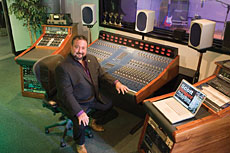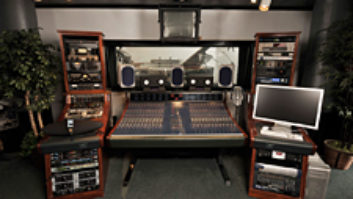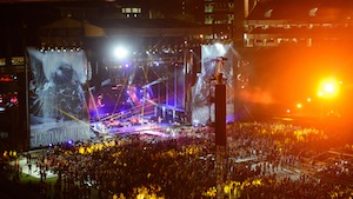
Twenty-three years ago, Scott Singer was a recent graduate of San Francisco State University — a composer/musician/recordist who was drawn to the place where music and technology meet. He bought a used Otari 8-track machine and put together his own composition studio, Space No. 5.
Singer and his custom “Bentley-edition” Oram console in the newly expanded home of Scott Singer Productions
Photo: Steve Jennings
“Then I upgraded to a Tascam 1-inch, 16-track system,” Singer recalls, “and locked it to an old ¾-inch video and ¼-inch SMPTE 2-track, and I was able to get a real good gig for the 50th anniversary of the Golden Gate Bridge.” Singer was part of a group of pre-MIDI engineer/musicians who developed an avant-garde musical piece for the event: “I worked with [Digidesign founder] Peter Gotcher. Paul de Benedictis [then of Opcode Systems] was one of the members, and we miked the giant cables of the bridge and recorded into an Apple computer and, with Peter’s string-emulating software, pitched the cables to create a suite of music where the bridge was the instrument.”
But not all of Singer’s projects have been that “out there.” In 1986, Singer broke into music for television, earning Emmy Awards for the theme music he wrote and performed for local program Evening Magazine and the national version, P.M. Magazine.
Then Singer began getting film projects for L.A.-based clients, such as producer Roger Corman, and each time he began a new phase of his professional/financial life, he upgraded his studio. Soon he was faced with the choice of leaving the Bay Area for a full-blown film music career in Los Angeles or staying in the place he’d called home since he was a child. Singer chose San Francisco, but that meant finding new ways to make a living.
“So the next career was corporate [work],” Singer says. “I became sort of the Paul Shaffer of Silicon Valley! I had singers coming in and they were recording songs, but they were songs and scores for Kawasaki or Nestlé or Silicon Graphics. Apple Computer took me to Japan, and I performed at the MacWorld Expo there. For five years, I was musical director for these companies, and I started to write more songs and scores for custom videos — all created in my studio. Then it all tanked in 2001, and I was saying, ‘What am I going to do now?’”
A lot of people would have downsized at that point, but Singer recently decided to take advantage of this slow period to reinvigorate his studio space. He commissioned a custom Oram GP4T console, flanked by Sound Construction mahogany sidecars that house an ever-expanding collection of outboard gear. “The left side has all the rich processing: the Neves, the GMLs, the UAs, even a ’50s Frank Sinatra — style RCA BA6A,” he says. “The right sidecar is all the newer stuff, the digital capture media: Pro Tools, Tascam 24- and 48-track HD decks, and CD/DVD recorders.”
Singer is proud of the console’s sound and look. He had met John Oram during his time working in L.A., and when he asked Oram to design the console, Oram went the extra mile. “The board is old-style analog, but with brand-new circuitry,” Singer explains. “It’s a design where you’ve got almost 56 inputs back into the board and 24 outputs at the same time with 24 mic pre’s and British EQ. And John has friends in England who gave us some Connelly leather [used to upholster Bentleys; note the leather accents above — Eds.], so this became, in a sense, the world’s first Bentley-edition mixing board!”
The studio’s main monitors are also custom-designed. “It’s a 5.1-ready system from Ed Long [EML],” he says. “His whole concept is that each speaker has its own time-aligned subwoofer. It creates a full-range sound from every speaker.”
Singer also expanded his facility by adding a 20×30-foot acoustic recording room, an edit room and live-loft to the existing suite, which already comprised a 20×40-foot control room and a vocal booth for music projects and ADR. And Singer is taking some chances these days with his projects. In addition to continuing to do corporate gigs, he’s writing and recording original music and then pitching it to filmmakers and TV producers. He’s developing and recording new artists, such as local singer Lauren Pease and African/world dance artist Salome, and he’s making good on a promise to himself to record his own progressive music. “I’ve gone full-circle back to songwriting,” he says. “The dynamic has changed from constantly looking for people to hire me to creating projects and then trying to sell them. After all these years, I’ve just got to go where the heart is leading.”
Singer Studio V7 officially goes online October 1, 2006, just in time for Singer to unveil it to friends visiting San Francisco for the AES convention.
Barbara Schultz is a Mix assistant editor.






